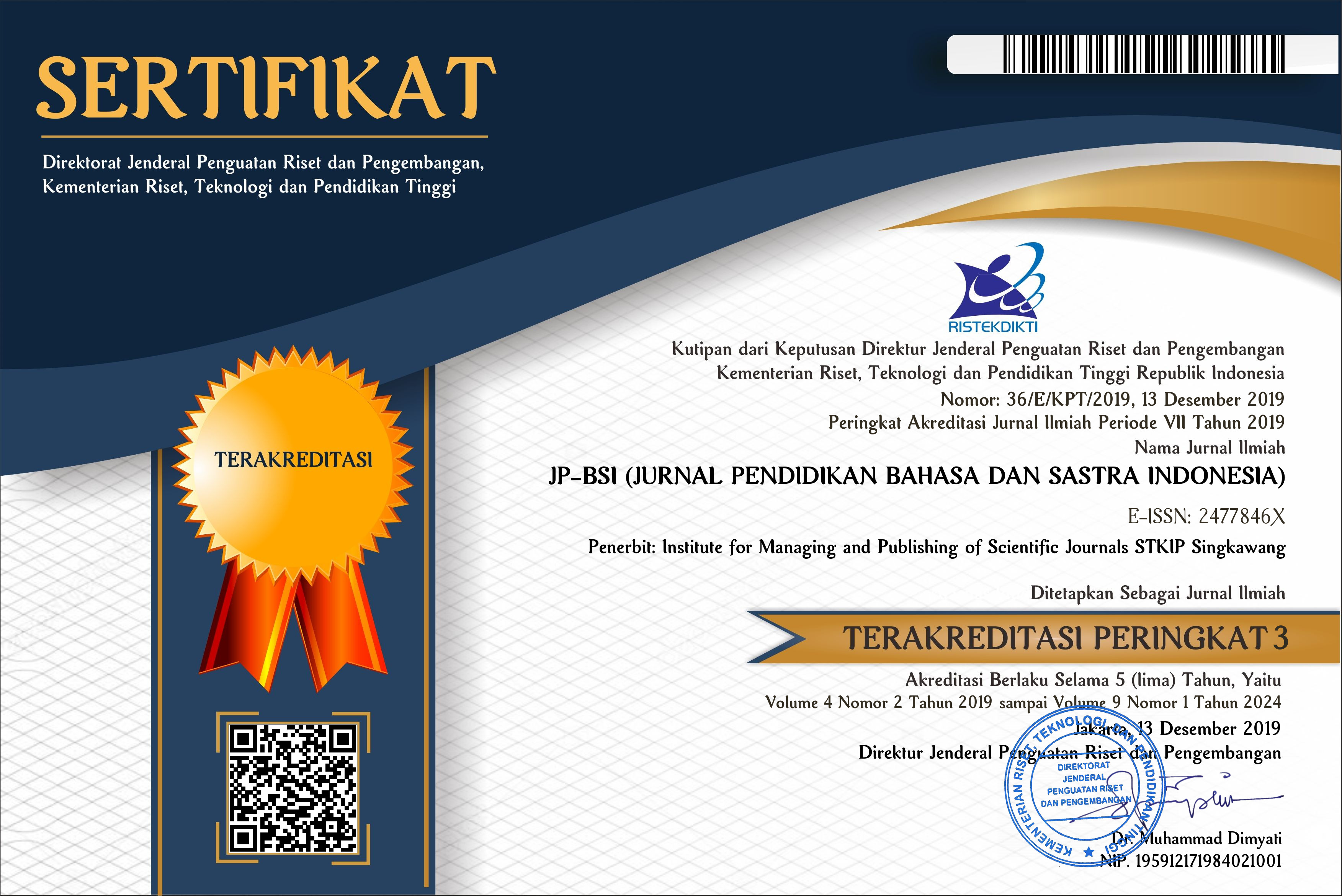Positioning the Chinese Princess of Peace in World Literature
Abstract
The novel Putri Cina or The Chinese Princess by Sindhunata builds on the intertextuality of various texts such as myths, chronicles, history, and pop culture. In the light of René Girard’s theory of desire, revenge, and scapegoating, this study aims (1) to show the inter-relationship among the texts in question; and (2) placing this novel in the work of World Literature. Through qualitative research methods and close reading techniques, this study finds out that Putri Cina recounts the history of conflicts to promote peace rather than revenge. The novel narrates such conflicts as the war between the descendants of the Javanese kings; the feud between the Chinese and Javanese people in colonial time; and the May 1998 ethnic riots in Indonesia. It concludes that it is necessary to circulate the narrative of the Chinese Princess as a peace ambassador in World Literature through the process of adaptation and translation. In a world prone to conflict, literary works can be effective agents of transformation.
Keywords
Full Text:
PDFReferences
Abshire, W. E. (2010). “Violence and the Sacred: Interpretations of René Girard in Christian Philosophy and Peace Studies.” Annales Philosophici, vol. 1, no. 1, hlm. 5-9.
Adolf, A. (2010). “What Does Peace Literature dDo? An Introduction to the Genre and Its Criticism”. Peace Research, vol. 42, no. 1/2, hlm. 9-21, 2010.
Berman, C. V. (2009). “The Known World in World Literature: Bakhtin, Glissant, and Edward P. Jones”. NOVEL: A Forum on Fiction, vol. 42, no. 2, hlm. 231-8.
Clayton, J & E. Rothstein. (1991). “Figures in the Corpus: Theories of Influence and Intertextuality” In Influence and Intertextuality in Literary History. Clayton and Rothstein. (hlm. 3-36). Madison: The University of Wisconsin Press.
Damrosch, D. (2009). How to Read World Literature. Oxford: Wiley-Blackwell.
Damrosch, D. (2011) “World Literature as Alternative Discourse” Neohelicon, vol. 38, no. 2, hlm. 307-17, 2011.
Dewi, N. (2019). “Putri Cina sebagai Duta Perdamaian dalam Sastra Dunia”. Dalam PROSIDING SEMINAR NASIONAL HISKI-MLI 2019 “Membaca Sindhunata: Perspektif Bahasa, Sastra, dan Budaya”. (hlm. 115-8). Yogyakarta: Fakultas Sastra USD.
Dewi, N. (Maret 2008). “Putri Pewarta Perdamaian: Kajian atas Putri Cina Karya Sindhunata”. Sintesis, vol. 6, no.1, hlm. 40-49.
Girard. R. (1986). The Scapegoat, trans. Yvonne Freccero. Baltimore, MD: Johns Hopkins University Press.
Hutcheon, L. (2006). A Theory of Adaptation. New York: Routledge.
M. H. Abrams, M. H. & G. Harpham. (2011). A Glossary of Literary Terms. Boston: Cengage Learning.
McQuillan, M. (2002). The Narrative Reader. London: Routledge.
Sindhunata, G. P. (2006). Babad Putri Cina. Jakarta: PT Gramedia Pustaka Utama.
Sindhunata, G. P. (2006a). Kambing Hitam: Teori René Girard. Jakarta: PT Gramedia Pustaka Utama.
Sindhunata, G. P. (2007). Putri Cina. Jakarta: PT Gramedia Pustaka Utama, 2007.
Sindhunata, G. P. (2015). The Chinese Princess. Translated by Katherine Rae and Simon Rae. Jakarta: PT Gramedia Pustaka Utama.
Tachtiris, C. E. (2012). “Branding World Literature: The Global Circulation of Authors in Translation”. Diss. Michigan University.
Yulianto, H. J. (2019). “‘Memento Mori’ dalam Novel Putri Cina karya Sindhunata: Membaca Mitos dan Sejarah sebagai Arketip dan Visi untuk Membangkitkan Kesadaran Moral dan Ekologis”. Dalam PROSIDING SEMINAR NASIONAL HISKI-MLI 2019 “Membaca Sindhunata: Perspektif Bahasa, Sastra, dan Budaya”. (hlm. 66-83). Yogyakarta: Fakultas Sastra USD.
Subana dan Sudrajat. 2005. Dasar-Dasar Penelitian Ilmiah. Bandung: Pustaka Setia.
The Only one. 2007. [Online].(http://theonlywann. blogspot.com/2007/11/bab-2. html dikunjungi 20 April 2017).
Yusuf, Muhammad, 2009. “Nilai Religi dalam Mantra Menanam Padi Masyarakat Melayu Desa Padu Banjar Kabupaten Kayong Utara (Skripsi)”. Pontianak: FKIP Universitas Tanjungpura.
DOI: http://dx.doi.org/10.26737/jp-bsi.v4i1.905
Refbacks
- There are currently no refbacks.
Published by:
Institute of Managing and Publishing of Scientific Journals STKIP Singkawang
e-ISSN: 2477-846X
p-ISSN: 2477-5932
Sekolah Tinggi Keguruan dan Ilmu Pendidikan (STKIP) Singkawang
Address : STKIP Singkawang, Jalan STKIP - Kelurahan Naram Singkawang, Kalimantan Barat, INDONESIA, 79251
No. Telp. : +62562 420 0344
No. Fax. : +62562 420 0342

Editor in Chief: [email protected] / Wa: +6281256252769
Coordinator: [email protected] / [email protected] / Wa: +6282142072788
Management Tools
JP-BSI Indexed by:
JP-BSI (Jurnal Pendidikan Bahasa dan Sastra Indonesia) is licensed under a Creative Commons Attribution-NonCommercial 4.0 International License.


















